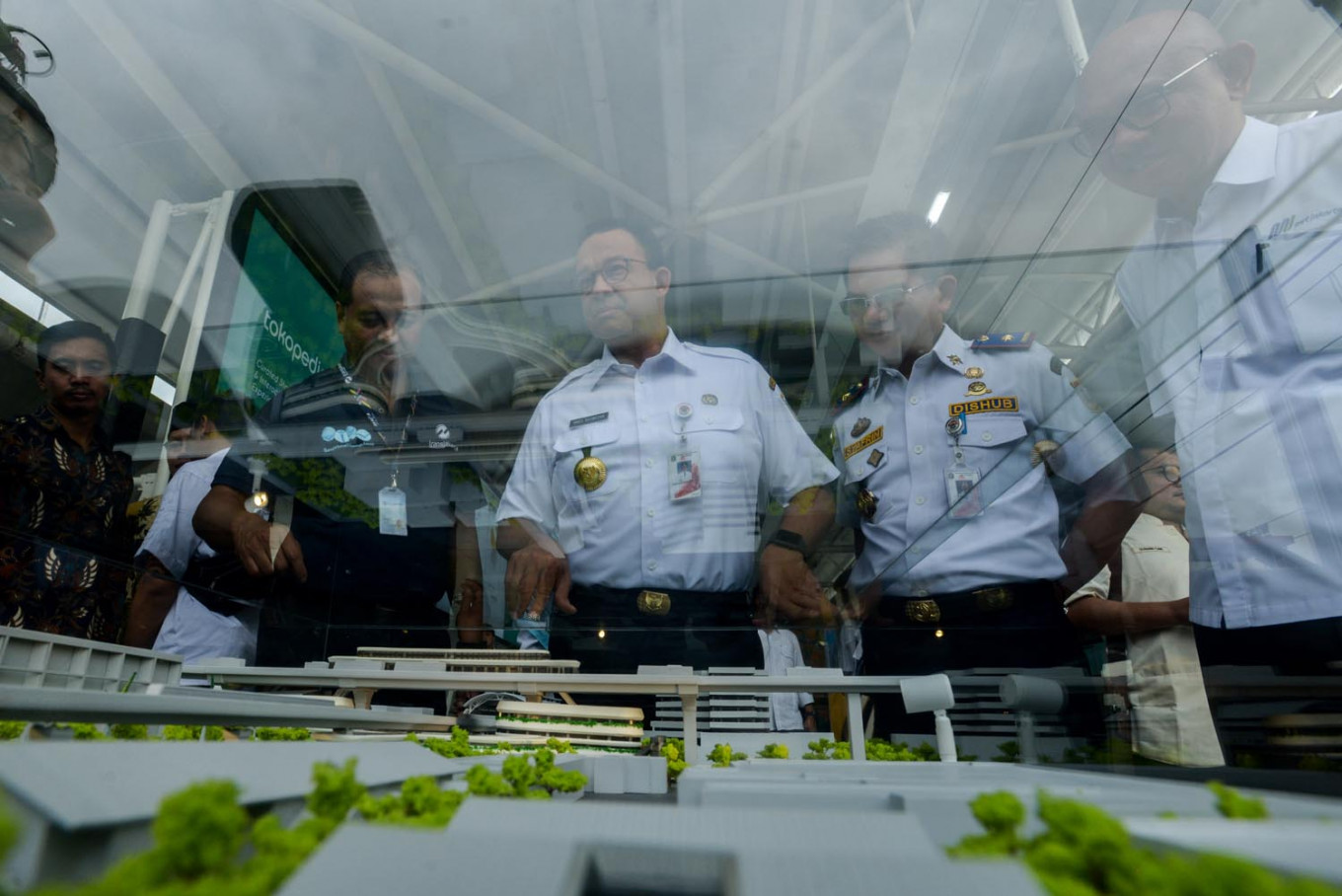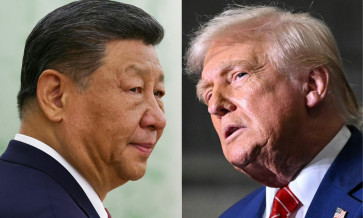Popular Reads
Top Results
Can't find what you're looking for?
View all search resultsPopular Reads
Top Results
Can't find what you're looking for?
View all search resultsMRT Jakarta to speed up transit-oriented development projects
After employing the odd-even license plate policy to prevent gridlock and expanding its inadequate sidewalks to increase footfall, authorities in Jakarta are focusing on improving more of the city’s transit hubs.
Change text size
Gift Premium Articles
to Anyone
 Jakarta Governor Anies Baswedan (second left) is accompanied by the managing director of Transjakarta, Agung Wicaksono (left), Jakarta Transportation Agency head Syafrin Liputo (second right) and MRT Jakarta managing director William Sabandar (right) as they look at a mockup of the ASEAN MRT station in Jakarta on Jan. 22. (Antara/Rivan Awal Lingga)
Jakarta Governor Anies Baswedan (second left) is accompanied by the managing director of Transjakarta, Agung Wicaksono (left), Jakarta Transportation Agency head Syafrin Liputo (second right) and MRT Jakarta managing director William Sabandar (right) as they look at a mockup of the ASEAN MRT station in Jakarta on Jan. 22. (Antara/Rivan Awal Lingga)
A
s a capital city notorious worldwide for its traffic problems, Jakarta has sought to shift its development to a more sustainable urban mobility model.
After employing the odd-even license plate policy to prevent gridlock and expanding its inadequate sidewalks to increase footfall, authorities are focusing on improving more of the city’s transit hubs.
City-owned mass transportation company MRT Jakarta, which was appointed the operator of the city’s transit-oriented development (TOD), is expected to commence revitalization projects at a number of busy transit hubs following the issuance of long-awaited urban development guidelines.
Three TOD designated zones in South Jakarta are expected to begin development: the Blok M-ASEAN, Lebak Bulus and Fatmawati MRT stations. They are among the five TOD projects along the city’s first MRT line, which also includes Dukuh Atas and Istora Senayan stations in Central Jakarta.
“The development of three TOD projects will be carried out in the near future,” MRT Jakarta spokesperson M. Kamaluddin told The Jakarta Post on Wednesday. He did not elaborate on any set date.
TOD has long been in MRT Jakarta’s pipeline but the recently signed urban development guidelines issued by Jakarta Governor Anies Baswedan finally give it a legal basis.
To ensure the project runs smoothly, the company plans to establish a dedicated subsidiary, PT Integrasi Transit Jakarta. The new entity will be 90 percent owned by MRT Jakarta, while the other 10 percent goes to Transjakarta, another city-owned transportation company.
“This subsidiary will become MRT Jakarta’s right-hand [man] when it comes to carrying out coordination and development activities,” MRT Jakarta president director William Sabandar said in a recent media briefing.
A dedicated task force has also been formed to prepare for all necessary procedures to speed up the project, he added.
The TOD project will add mixed-use development, expand sidewalks and public spaces, install bike-sharing facilities and plant trees for the green belt. Mixed land use may offer development opportunities for residential, business and leisure purposes, the company says.
“Space for parking lots will also be reduced […] With the TOD, we are hoping the number of private vehicle users will drop off,” William said.
The number of daily trips in and out of Greater Jakarta has almost doubled from 47.5 million in 2015 to 88 million in 2018, according to data from the Greater Jakarta Transportation Agency. As Jakarta is still the main destination for commuters, there is an increasing sense of urgency to improve urban mobility in the agglomeration area.
Of the 3.2 million daily commuters in Greater Jakarta, some 72 percent still use private vehicles.
Jakarta’s MRT line is expected to persuade private vehicle users to shift to public transportation. The attempt seems to be on track as the company had seen increased demand and a revival of businesses located in the vicinity of its stations, after just one year of becoming operational, William claimed.
Before the COVID-19 outbreak, the company recorded an average of 100,000 passengers a day, increasing from nearly 80,000 during the first month of operation. The MRT line was launched on March 24 last year.
Even as the capital transitions out of a partial lockdown to curb the spread of the virus, MRT passenger numbers have slowly increased to 20,000 people a day as of Thursday since restrictions were eased in June.
The company previously recorded lower than 1,000 passengers a day on some days during the three-month period of restrictions.
Development at each of the three TOD locations, which covers a total area of 113 hectares, will employ different urban renewal concepts to account for their distinct characteristics.
“The TOD concept for Fatmawati will be one of dynamic vertical space. The Blok M-ASEAN station will become a ‘green creative hub’ as we want to turn the area back [into a green belt]. We also want to make Lebak Bulus a terminus, a gate to Jakarta’s south,” William explained.
The project, restricted only by a limited infrastructure development budget, is likely to require a longer time to finish. As a result, the company will pursue business-to-business (B2B) schemes as the main funding option.
“The results will probably be seen within 10 or 20 years,” he said.
TOD is nothing new in Indonesia, as other state institutions have similar ongoing projects all around the country’s urban center, Greater Jakarta.
State-owned railway operator PT KAI has a partnership with state builder PT Perumnas to develop TOD zones near four commuter line stations, namely Tanjung Barat Station in South Jakarta, Pondok Cina Station in Depok, Rawabuntu Station in South Tangerang and Bogor Station in Bogor.
Under the scheme, the companies plan to build a total of 13 apartment towers – six near Bogor Station, three at Rawabuntu, two in Pondok Cina and two in Tanjung Barat – complete with public and commercial facilities.
In addition to Perumnas, KAI has also joined hands with state-owned PT Pembangunan Perumahan (PP) for a similar apartment development project around the Juanda railway station in Central Jakarta.
Mulya Amri, program director of the Jakarta Property Institute, said the TOD might become a more attractive concept after the COVID-19 outbreak subsides, as mixed land use offers reduced travel distances for retail, logistics and even work, if offices are also built near the area.
“[People] can gain access to basic needs by walking or biking without necessarily taking public transportation. This may be safer in terms of COVID-19 prevention,” he said.









